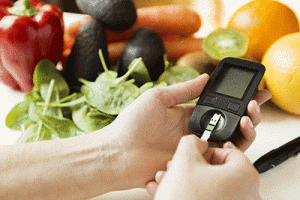Diabetic Blood Glucose Management
Managing diabetes is a multifaceted task that diabetics must face every day. Many variables must be taken into consideration to lead a productive, healthy life as a diabetic. Of course, diabetic meal planning and blood glucose monitoring are primary concerns for a diabetic, yet other factors add to the equation that are not so readily evident. Some of these factors include diabetic diet and nutrition, diabetic insulin administration, diabetic activity planning, diabetic stress management, and diabetic rest management. All of these factors play an important part in managing diabetes. With so many variables to consider it is difficult to say that one factor is more important than the other. In truth, it can and will vary from day today. Some days activity levels will be higher and as a result insulin needs will necessarily be less to maintain ideal blood glucose levels. Other days stress levels may be very high and oddly cause blood glucose levels to be unexpectedly high and in turn, create a need for added diabetic insulin administration. Sick days as an example can be very complex as insulin and food needs will be different from normal days. Perhaps one of, if not the most challenging factors in managing diabetes is that of managing low blood glucose levels, something every diabetic can relate to.
Diabetic Low Glucose Levels
When it comes to managing diabetes, low blood glucose levels are a constant concern. Often low blood glucose levels, also known as an insulin reaction, come on when least expected and more often than not at the most inopportune moments. A low blood glucose level, as it sounds is a lower than normal amount of glucose, a sugar used by the body in every cell. This low blood sugar level can be brought on by many things, though generally speaking, the insulin level in the body is too high in relation to the amount of glucose in the blood. Some of the symptoms of low blood glucose level are nausea, sweating, intense hunger, faintness, fatigue, and if not treated can lead to worse. Many, many things may have occurred to bring the blood glucose level so low. For a diabetic, these low blood glucose levels can be very dangerous and even fatal if not addressed immediately. For this reason, I consider managing low blood glucose levels the most critical part of managing diabetes.
Managing Low Blood Glucose Levels With Diabetes

Managing low blood glucose levels is something that every diabetic can and should expect. The most successful methods for managing blood glucose levels are multifaceted and though not foolproof have many layers to cover even the most critical of situations. Having some hard candy or sweets on hand is one traditional method of addressing low blood glucose levels. Planning activities well and knowing well the demands that will be placed on the body in terms of blood glucose usage will be inherent in preventing low blood glucose levels. Diabetic meal planning is another method to avoid dealing with the complications of low blood glucose levels. Maintaining a good backup plan to remedy low blood glucose levels if diabetic meal planning, diabetic activity planning, and having some sort of simple sugar on hand have still given way to low blood glucose levels is an absolute necessity! As a matter of fact, having a secondary and even tertiary backup plan is more than a good idea.
One of the 1st remedies for low blood glucose levels I ever heard of came to me years before I was diagnosed with type 1 diabetes. It was the subject of a PBS after school special about a kid at summer camp who was a diabetic and encountered a low blood glucose level while swimming in the camp pool. There was an irony presented in the special about diabetes, in that the kid who was a diabetic and “supposed to stay away from sugar,” carried some hard candies with him that would help if he encountered low blood glucose levels. Naturally, the other kids at the camp were critical of him for having some simple sugar on him though he was a diabetic. This dichotomy of sugar has always been the mystery of diabetes. On one hand, too much sugar or carbohydrates, in general, can lead to elevated or high blood glucose levels, also known as hyperglycemia. On the other hand, too little sugar can lead to low blood glucose levels, also known as hypoglycemia. This paradox is a complex part of managing diabetes. At any rate, I will always have some sort of non-perishable, factory wrapped form of sugar on me at all times. Generally, I’ve found several companies that make individually wrapped ginger candies. I can take these with me anywhere and everywhere without fear of them spoiling. I love to spend time outdoors, especially swimming and surfing and these little ginger candies are always handy. That being said, almost any factory sealed candy can be a real life-saver in the event of a low blood glucose level.
Managing Blood Glucose Levels With Activity
As a diabetic, leading an active or relatively active lifestyle is extremely important. Daily activities will help to stimulate the metabolism and assist the body in regulating blood glucose levels. To this end, diabetic activity planning is an integral part of managing blood glucose levels. Planning every detail of every day can be monotonous and can make one feel like an automaton, yet “an ounce of prevention is worth a pound of care,” rings very true when it comes to diabetic activity planning. This is not to say that you have to plan every step of every day, but having a good idea of what each day has in store can help when it comes to insulin administration and diabetic meal planning. For instance, a day full of hiking, swimming, surfing, or other such activity is going to have a significant effect on blood glucose levels and taking the time to account for this will make those important activities easier and more rewarding. Keeping records of blood glucose levels before, during, and after activity over time can greatly help in diabetic activity planning. Coupled with diabetic activity planning is diabetic meal planning. The two go hand in hand in managing blood glucose levels.
One of, if not the most important steps in managing diabetes is diabetic meal planning. Planning meals ahead of time can save time, money, and energy. It will also prevent eating low-quality fast foods in response to “not having enough time,” to adequately prepare for the day and eating “on the run.” Diabetic meal planning can be done in any number of different ways using a variety of techniques; from simply having adequate food in the home, including ready to eat snacks and easy to make meals to prepping, cooking, and portioning meals that are eaten throughout the week. When it comes to managing blood glucose levels, planning meals ahead of time can really make a diabetic’s life so much easier. Planning meals allow a diabetic to make healthy choices and not be so subject to the whims of low blood glucose levels. Diabetic meal planning can take away much of the guesswork of managing diabetes, yet no plan is foolproof and circumstances of daily life change all the time usually with no prior notice. For this reason, it is good to have a good backup plan, secondary and tertiary backup plans, and even a safety net for when those fail.
Fluctuating Blood Glucose Levels In Diabetics
No amount of planning can relieve the unexpected ups and downs of daily life. For a diabetic, these ups and downs can be very critical and unfortunately can sometimes mean the difference between life and death. Critically speaking, low blood glucose levels can lead to a diabetic induced coma and even death if not addressed quickly. When it comes to this a diabetic can never play it too safe. When I was young my mom always made sure I had a few extra dollars on me in case I needed to get some juice, soda, or another form of sugar in case my blood glucose level got too low. This was very helpful yet there were times that there was not a store or vending machine close by with which to purchase something to bring my blood glucose level back up to par. Having some sort of candy, soda, or sugar of some kind on hand has also been very helpful. Sometimes blood glucose levels will continue to drop and all of the cash, sugar, and planning has not remedied the low blood glucose level. This incident can be very critical and dangerous. Over the years I have started to carry honey packets in my car, backpack, suitcase, pocket, and just about anywhere I can for just such an emergency. Honey is a perfect form of sugar and naturally never biodegrades. Over time, honey can crystallize especially if exposed to heat. These crystals can still be consumed and if warmed in a water bath will return to a liquid state. Honey is a wonderful tool in remedying low blood glucose levels. Having a backup plan is as important as having a backup plan for your backup plan. No amount of overthinking is worth the consequences of a critically low blood glucose level.
Over the years I have experienced many low blood glucose levels, some of the more critical and dangerous than others. It is a very uncomfortable situation and has put me in some very compromising positions. Fortunately for me, I have been lucky enough to have never been admitted to the hospital for complications of diabetes since my initial diagnosis in 1986. I do consider myself one of the lucky ones and am grateful for the success I have had in managing diabetes.
In conclusion, managing low blood glucose levels is a very important and sometimes critical part of managing diabetes. Some of the techniques of managing low blood glucose levels I’ve touched on are having some candy or recovery sugar of some kind on hand, diabetic activity planning, diabetic meal planning, and lastly a series of backup plans to use when all else fails. All things considered, nothing can prepare one for the unexpected and having many tools in the arsenal will make managing low blood glucose levels and in turn, managing diabetes that much easier.
Tasty Diabetic-Friendly Recipes
Try out some of these delicious healthy recipes I’ve come up with that are healthy for everyone:
Grilled Vegetables
Crock Pot Chicken Soup
Tasty Guacamole
Scrambled Eggs and Broccoli
Rotisserie Chicken Tacos
Helpful Weight Loss And Diet Tracker
And for those of you who need a little push to stay on track with your healthy eating and weight loss, check out this helpful diet tracking program called Noom.
About Our Guest Writer:
Tim Delaney, Content Writer. Tim studied Environmental Science at the University of California, Santa Barbara. He is an avid outdoor enthusiast, loves to surf, is passionate about health, and discovering ways to enjoy life with diabetes.

Advertising Disclosure: This post contains affiliate links and at no additional cost to you, Watch the Review may be compensated if you make a purchase after clicking on these links.


Wonderful reading, so informative!
Thanks Scottie! Our guest writer, Tim Delaney, is contributing quite a few articles on the subject of diabetes and more are on there way. Glad they are helpful to you. ~ WTR Team
Cool
This is amazing and cool and you should keep doing it